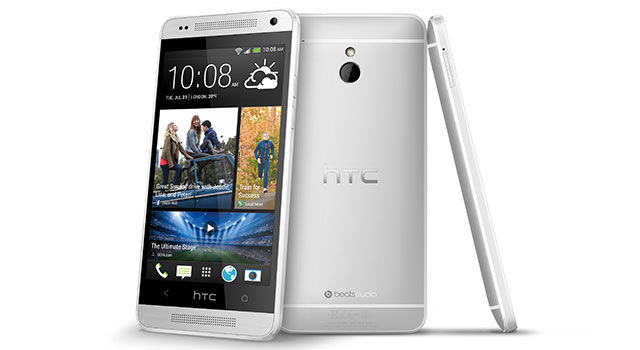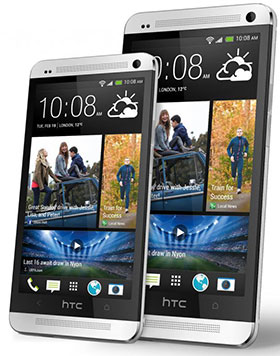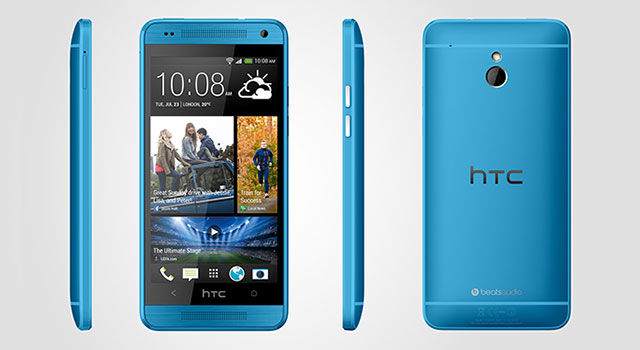
HTC has taken a leaf out of Samsung’s book by offering a “mini” version of its flagship handset. Samsung had the Galaxy S3 Mini, and now the S4 Mini, and now its Taiwanese rival has followed suit with the HTC One Mini, a pared-down version of the HTC One.
The HTC One Mini is a midrange smartphone. Both it and its bigger brother have the same industrial design — a mix of aluminium and polycarbonate plastic — for a solid feel in the hand. However, the edges of the One Mini are plastic, giving the device a less refined look than the One. But it is still a good-looking phone.
The One Mini has a smaller, 4,3-inch, 720p display with a 16:9 aspect ratio, compared to the 4,7-inch 1080p screen found on the One. For a “mini” handset, it’s far from small, and still larger than the iPhone 5s. The 720p screen is impressive — the 341-pixels-per-inch display is great for photo viewing and video playback and text is sharp.
Its elongated form factor is very similar to Apple’s iPhone 5 and 5s models and is only slightly heavier at 122g despite its bigger proportions. The power button is located at the top next to the 3,5mm audio jack, the volume keys to the right side, and the charging port is at the bottom.

There are no physical front buttons, but rather two soft buttons — back and home — that appear on either side of the HTC logo. If you’ve used Android on a handset other than an HTC, you may find yourself hitting the HTC logo in error, because that’s where the home button should be placed, logically.
The handset has the same front-facing stereo speakers found on the HTC One, featuring HTC’s own “BoomSound” with built-in amplifier, which is over and above the bass-heavy Beats Audio integration that can be turned off. The combination of great sound and an excellent screen makes it ideal for catching up on TV series while on the go, or just watching high-definition YouTube videos.
Under the hood, the One Mini is stripped down compared to the One: it has a 1,4GHz dual-core Snapdragon 400 processor, 1GB of RAM and 16GB of non-expandable storage, while the One has a quad-core Snapdragon 800 processor, 2GB of RAM and minimum of 32GB of storage. Connectivity options on the handset include LTE, Wi-Fi, Bluetooth 4.0 and GPS.
Features that appear on the One, and not the One Mini are near-field communication, optical image stabilisation on the camera, and an infrared blaster.
At the speed smartphone technology is moving today, the One Mini already feels a bit dated — or perhaps aimed at someone who wants to switch to a smartphone for the first time without worrying about having the latest and greatest gadget.
The One Mini ships with Android Jelly Bean 4.2.2 and version 5 of HTC’s love-it-or-loathe it Sense Android overlay, which brings BlinkFeed to your homescreen.
BlinkFeed pulls content from your connected social media accounts and news headlines. Thankfully, it’s possible to tell this data-hungry service to update only when you’re in a Wi-Fi hotspot.
The feed sits on the extreme left homescreen and cannot be disabled or tweaked to your liking, so you’re forced to use it whether you like it or not. The closest to customisation you get is selecting which news feeds to use.

The One Mini has a camera very similar to the One, which makes use of an Ultrapixel sensor that is great for photos in low-light conditions. It has a 4-megapixel rear camera and a 1,6-megapixel front camera with LED flash. However, there’s no optical image stabilisation. The main camera takes decent photos, but we found pictures on high dynamic range mode a bit oversharpened.
HTC Zoe, a feature that lets you shoot three-second videos while taking photos, is available on the Mini. Playback is only available on the device as you can’t do anything else with it — such as sharing it on social networks or via e-mail. The One Mini shoots video in full 1080p on the rear camera, while the front one allows for 720p.
The battery is 1 800mAh, compared to the 2 300mAh found on the One. The slower processor and smaller screen mean the reduction in size is okay and the Mini will take most users through a day of above average use. Overall, the HTC One Mini is a great looking phone with an excellent screen, but it’s let down by its slightly dated specs. If you get one now, you will probably regret it long before you’re due for your next upgrade.
The HTC One Mini has a recommended retail price of R5 500 and is available through Vodacom and Cell C. MTN plans to offer the handset in the first quarter of 2014. — (c) 2013 NewsCentral Media
- See also: This is it: the HTC’s flagship reviewed




